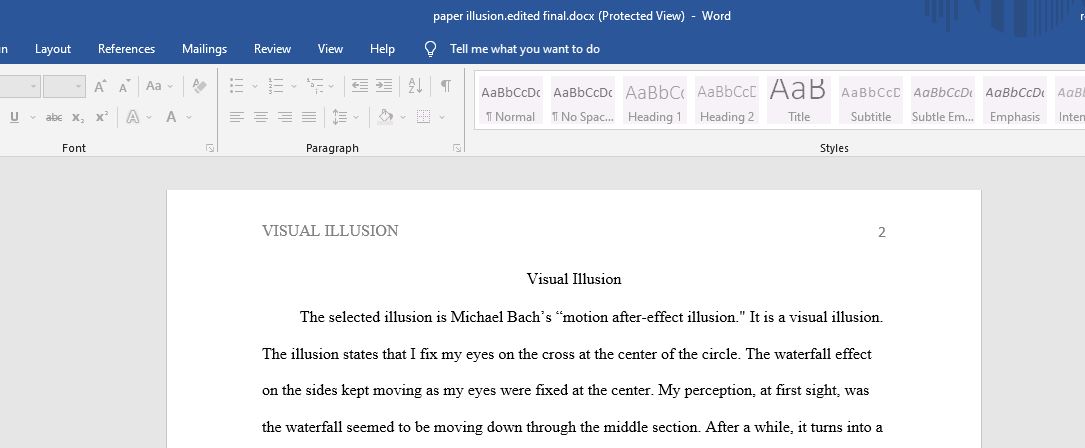Write about a selected optical illusion.
Illusion Assignment
An illusion is when your interpretation or perception contradicts the real sensory stimulus and is part of normal perception. In this course we have briefly discussed many illusions and different illusions may occur for different reasons. Research has also shown that for some illusions there are cultural influences (among other things, like age) that can affect whether or not a person is susceptible to the illusion.
Our perceptions can also be affected by our beliefs, values, prejudices, expectations, and life experiences. For instance, Segall, Campbell, and Herskovits (1963) demonstrated that individuals from Western, European cultures were more likely to experience certain types of visual illusions than individuals from non-Western cultures, and vice versa. Westerners were susceptible to the Müller-Lyer illusion, where equal length lines appear to be different lengths.
These differences are likely due to differences in visual experiences and the types of environmental features experienced on a regular basis by people in a given cultural context. People in Western cultures have a perceptual context of buildings with straight lines. In contrast, people from some non-Western cultures, such as the Zulu of South Africa, have villages made up of round huts arranged in circles and are less susceptible to this illusion.
Similarly, Doherty, Tsuji, and Phillips (2008) study showed cultural differences in the Ebbinghaus illusion, where same-sized circles appear to be different sizes based on surrounding circles.
They found that Japanese adults were significantly more influenced by context (i.e., more misled by the surrounding circles) than adults in the UK. These cultural differences generally support that this illusion is also due to learning, not to different innate cognitive or perceptual systems. Consistent with this, Doherty et al. (2010) showed that children were less susceptible to this illusion than adults. Children under age 7 did not show effects of this illusion and even by 10 performance was not at adult levels.
With this assignment, you will pick an illusion and write a 2-3 page paper about it. You should include the following information:
1. Describe the illusion. Does it have a name and what is the illusion? In describing it, you should explain what you perceive and what it is in reality (i.e. you perceive movement of … when in reality it is a stationary image, etc.). What is interesting about the illusion and how does it connect to sensation and perception (i.e. is it a visual illusion, an auditory illusion, etc.)? (20 points)
2. Explain how/why the illusion works. Is it more related to properties of the sense organ (i.e. the eye, etc.) or more to brain interpretation? Does it rely on context or perceptual tricks or something else? Be specific in explaining what is happening to cause the illusion (50 points)
3. State whether or not you think the illusion would have cultural effects, as in the above examples. Why or why not? Is the illusion a learned illusion, meaning is experience necessary for it to develop? How is the illusion influenced by context? (There is no right answer to this, but use information from the examples to make a hypothesis) (30 points)
You can pick any illusion you like (other than the above examples – Ebbinghaus and Muller-Lyer). Here are some resources to help you find an illusion, but you can choose any illusion you like and it does not have to be from one of these sources.
This page includes a number of illusions and at the bottom are links to many more illusions: http://www.ritsumei.ac.jp/~akitaoka/index-e.html
auditory illusions: https://www.newscientist.com/article/dn13355-sound-effects-five-great-auditory-illusions/
auditory illusions (including video can you trust your ears?): https://blog.teufelaudio.com/auditory-illusions/
tactile illusions: https://www.scientificamerican.com/article/touching-illusions-2008-05/
References
Doherty, M.J., Tsuji, H., and Phillips, W.A. (2008). The context-sensitivity of visual size perception varies across cultures. Perception, 37(9), 1426-1433.
Doherty, M.J., Campbell, N.M., Tsuji, H., and Phillips, W.A. (2010). The Ebbinghaus illusion deceives adults but not young children. Developmental Science, 13(5), 714-721.
Segall, M.H., Campbell, D.T., and Herskovits, M.J. (1963). Cultural differences in the perception of geometric illusions. Science, 139, 769-771.
Answer preview:
word limit:640

